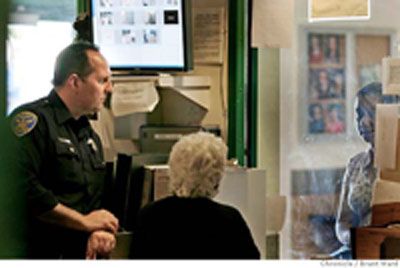| The relationship between the media and law enforcement is often adversarial. Reporters appear to seek the sensational elements of a crime story, often to the detriment of the police, and officers tend to be uncooperative with journalists they seem to instinctively mistrust. Not so with “The Badge,” a new series presented by a San Francisco Chronicle reporter/photographer team embedded with the SFPD. Kudos to the Chronicle for pursuing this series and to the officers who willingly put themselves in the media spotlight in the hopes of helping civilians develop a better understanding of life behind the badge. You’re putting a human face on “the police,” which will benefit us all. |
By John Koopman
San Francisco Chronicle
|
|
SAN FRANCISCO, Calif. — Officer Tom Maguire is working the front desk of the Mission Station.
Cops don’t like to work the front desk. The veterans, as they load their shotguns and slide into patrol cars, tease the rookies about getting stuck with that duty.
“I definitely prefer to be on patrol,” Maguire said. “That’s what I trained for -- police work.”
But it has to be done. It goes to “Junior Chipmunk” -- in the words of station commander Capt. John Goldberg -- or an officer on light duty because of an injury, or to a cop who is left solo because a partner is gone for the day.
“This is not police work,” Maguire says, tapping the keyboard as he gathers information for a hit-and-run report. It’s a month-old incident, and the woman at the window needs the report for her insurance company.
Maguire is 34 and has been on the job for two years. Tall, balding and bespectacled, he looks a lot like a broker for Charles Schwab, which was the job he held for eight years before deciding to become a cop.
On the other side of the bullet-proof glass are a half-dozen people who need help. This one has a beef with a ticket, that one had his laptop stolen from a hotel room, the other one was beaten up the night before.
The police radio crackles in the background. The dispatcher’s calm voice is just white noise.
Until something happens. You can hear a subtle shift in tone, and urgency. Like now. There’s been a shooting in a park just two blocks away.
“Report of five Latin males running north on Valencia,” the dispatcher says.
Maguire realizes if that’s correct, the men are running directly toward the station.
He’s lucky because today he has help at the front desk. Nancy Callaghan, a civilian police services aide, also is taking reports. Maguire runs to the doors leading to Valencia and looks south. No one. But he can see the patrol cars speeding toward the park, and he knows that’s where the action is. Callaghan has the desk under control.
People who wear guns for a living classify humanity into two groups: Those who logically run from the sound of gunfire, and those who run toward it.
“I can’t resist,” Maguire says with a smile as he runs out the door.
The park is remarkably calm, considering what’s happened. A couple dozen young men and boys gather in clusters, as two homeless men sleep in the shade to the side. About two dozen young children huddle near the playground as their adult supervisors try to keep them calm.
The shooter is still at large.
The victim is on his feet. Fire trucks have arrived, and the man walks to the medics as they approach. He has a bullet hole in his back, a small trickle of blood seeping down toward his shorts.
There are conflicting accounts of what happened, and how many shots were fired.
Not surprisingly, it is a gang-related shooting. This park sits between the areas claimed by the two rival Latino gangs, the Norteños and Sureños, but it’s mostly Sureños who hang out here. Sureños wear blue, and there are a lot of blue athletic shirts and shorts on people in the crowd.
“I saw this guy walk up and say, ‘What’s with the number 8 on your jersey?’ ” one witness tells police.
Maguire joins several other officers at the scene and begins interviewing possible witnesses.
“Does anyone speak English?” he asks a group of soccer players. “No one? Not even a little bit?”
Sgt. Larry Gray is on the scene. He hands Maguire a clipboard with the crime-scene log, and the junior officer goes to work. He gets a roll of yellow tape and starts marking off the area where the shooting occurred, letting the trail of blood and the pile of bloody clothing guide him.
He got his field training after the academy at the Bayview Station, so he’s had a lot of experience at this.
Slowly, people leave the park. Other officers arrive on the scene. Some are conducting interviews, many are searching the neighborhood for the shooter.
The details of the shooting start to come out. Some guys were playing soccer, and a bunch of them wore blue. A Sureño gang member approached them and announced that if they weren’t in the gang they had no business wearing blue.
One man apparently didn’t think that was fair. And said so.
The suspected gang member pulled a handgun and shot three times. He hit the victim twice: once in the arm and once in the side.
A little more than an hour after Maguire arrives, he’s released, and he walks back to Mission Station.
There’s a hit-and-run report waiting for him at the front desk.
Read the Badge Blog
Copyright 2007 San Francisco Chronicle



